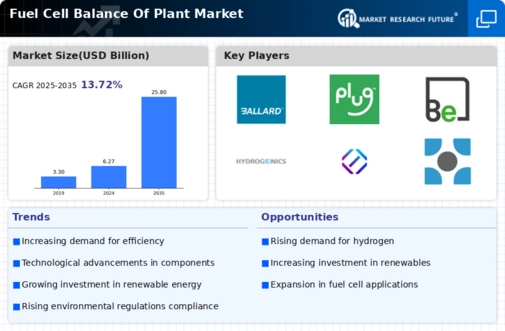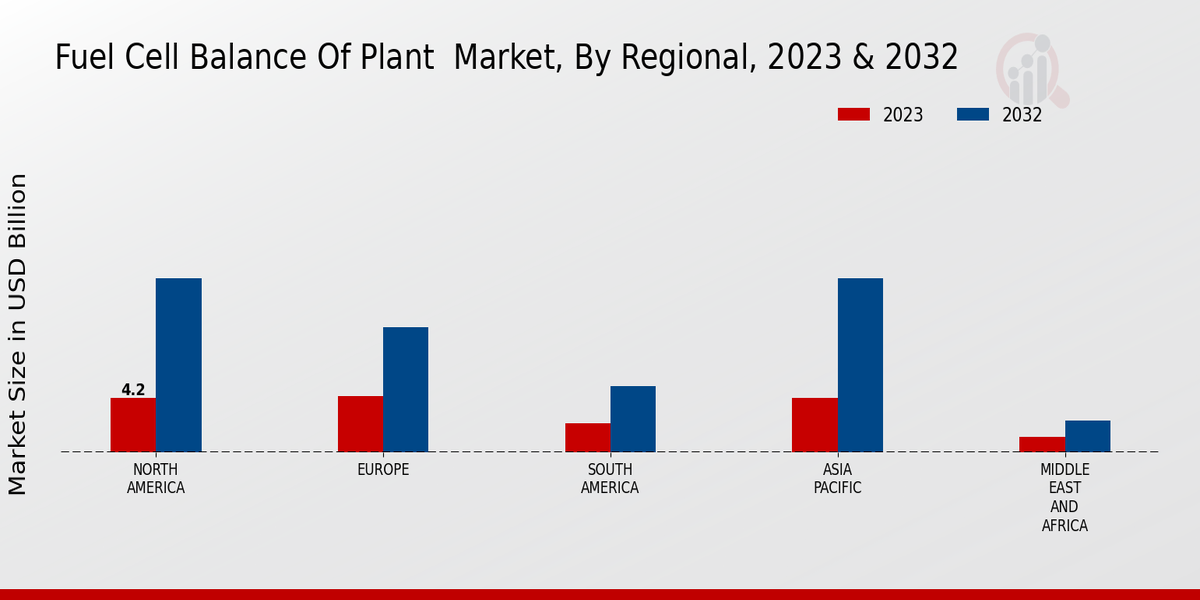Market Growth Projections
The Global Fuel Cell Balance Of Plant Market Industry is poised for substantial growth, with projections indicating a market value of 6.27 USD Billion in 2024 and an anticipated increase to 25.8 USD Billion by 2035. This growth trajectory reflects a compound annual growth rate (CAGR) of 13.71% from 2025 to 2035, driven by various factors such as technological advancements, government support, and rising environmental awareness. The market's expansion is indicative of the increasing adoption of fuel cell technologies across multiple sectors, positioning fuel cells as a critical component in the global transition towards sustainable energy solutions.
Government Initiatives and Funding
Government initiatives and funding are crucial drivers for the Global Fuel Cell Balance Of Plant Market Industry. Various countries are implementing policies that support the development and deployment of fuel cell technologies. For instance, the United States Department of Energy has allocated substantial funding for research and development in hydrogen and fuel cell technologies, aiming to enhance energy security and reduce reliance on fossil fuels. Such initiatives not only foster innovation but also create a favorable environment for market growth, with projections indicating a market value of 25.8 USD Billion by 2035, reflecting the increasing governmental support for clean energy.
Diverse Applications Across Industries
The versatility of fuel cells is a key driver of the Global Fuel Cell Balance Of Plant Market Industry, as they find applications across various sectors, including transportation, stationary power generation, and portable power. For instance, fuel cells are increasingly being utilized in public transportation systems, such as buses and trains, to reduce emissions and improve air quality. Additionally, the integration of fuel cells in backup power systems for critical infrastructure demonstrates their reliability and efficiency. This diverse applicability not only broadens the market scope but also enhances the overall demand for fuel cell technologies, contributing to the industry's robust growth trajectory.
Rising Awareness of Environmental Issues
Rising awareness of environmental issues among consumers and industries is significantly influencing the Global Fuel Cell Balance Of Plant Market Industry. As climate change concerns escalate, there is a growing demand for sustainable energy solutions that minimize carbon footprints. This shift in consumer preferences is prompting industries to explore cleaner alternatives, including fuel cells, which offer zero-emission energy generation. The increasing public awareness and advocacy for environmental sustainability are likely to accelerate the adoption of fuel cell technologies, further propelling market growth and solidifying the role of fuel cells in the transition to a low-carbon economy.
Growing Demand for Clean Energy Solutions
The Global Fuel Cell Balance Of Plant Market Industry is experiencing a surge in demand for clean energy solutions as nations strive to meet stringent environmental regulations. Governments worldwide are increasingly promoting the adoption of hydrogen fuel cells as a sustainable alternative to fossil fuels. For instance, the European Union has set ambitious targets for reducing greenhouse gas emissions, which has led to increased investments in fuel cell technologies. This shift towards cleaner energy sources is projected to drive the market to an estimated value of 6.27 USD Billion in 2024, highlighting the growing recognition of fuel cells as a viable energy solution.
Technological Advancements in Fuel Cell Systems
Technological advancements play a pivotal role in the Global Fuel Cell Balance Of Plant Market Industry, enhancing the efficiency and performance of fuel cell systems. Innovations in materials, such as the development of more durable membranes and catalysts, have significantly improved the longevity and efficiency of fuel cells. For example, advancements in solid oxide fuel cells (SOFCs) have led to higher operating temperatures and improved energy conversion rates. These innovations not only reduce operational costs but also increase the attractiveness of fuel cells for various applications, potentially contributing to a market growth rate of 13.71% CAGR from 2025 to 2035.






















